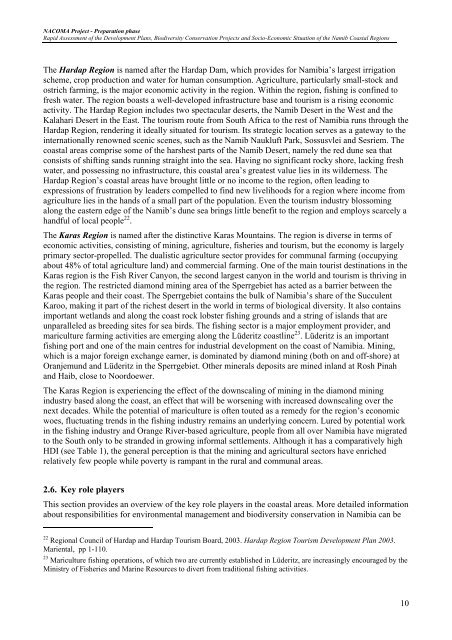Full report LR.pdf - DLIST Benguela
Full report LR.pdf - DLIST Benguela
Full report LR.pdf - DLIST Benguela
- No tags were found...
Create successful ePaper yourself
Turn your PDF publications into a flip-book with our unique Google optimized e-Paper software.
NACOMA Project - Preparation phaseRapid Assessment of the Development Plans, Biodiversity Conservation Projects and Socio-Economic Situation of the Namib Coastal RegionsThe Hardap Region is named after the Hardap Dam, which provides for Namibia’s largest irrigationscheme, crop production and water for human consumption. Agriculture, particularly small-stock andostrich farming, is the major economic activity in the region. Within the region, fishing is confined tofresh water. The region boasts a well-developed infrastructure base and tourism is a rising economicactivity. The Hardap Region includes two spectacular deserts, the Namib Desert in the West and theKalahari Desert in the East. The tourism route from South Africa to the rest of Namibia runs through theHardap Region, rendering it ideally situated for tourism. Its strategic location serves as a gateway to theinternationally renowned scenic scenes, such as the Namib Naukluft Park, Sossusvlei and Sesriem. Thecoastal areas comprise some of the harshest parts of the Namib Desert, namely the red dune sea thatconsists of shifting sands running straight into the sea. Having no significant rocky shore, lacking freshwater, and possessing no infrastructure, this coastal area’s greatest value lies in its wilderness. TheHardap Region’s coastal areas have brought little or no income to the region, often leading toexpressions of frustration by leaders compelled to find new livelihoods for a region where income fromagriculture lies in the hands of a small part of the population. Even the tourism industry blossomingalong the eastern edge of the Namib’s dune sea brings little benefit to the region and employs scarcely ahandful of local people 22 .The Karas Region is named after the distinctive Karas Mountains. The region is diverse in terms ofeconomic activities, consisting of mining, agriculture, fisheries and tourism, but the economy is largelyprimary sector-propelled. The dualistic agriculture sector provides for communal farming (occupyingabout 48% of total agriculture land) and commercial farming. One of the main tourist destinations in theKaras region is the Fish River Canyon, the second largest canyon in the world and tourism is thriving inthe region. The restricted diamond mining area of the Sperrgebiet has acted as a barrier between theKaras people and their coast. The Sperrgebiet contains the bulk of Namibia’s share of the SucculentKaroo, making it part of the richest desert in the world in terms of biological diversity. It also containsimportant wetlands and along the coast rock lobster fishing grounds and a string of islands that areunparalleled as breeding sites for sea birds. The fishing sector is a major employment provider, andmariculture farming activities are emerging along the Lüderitz coastline 23 . Lüderitz is an importantfishing port and one of the main centres for industrial development on the coast of Namibia. Mining,which is a major foreign exchange earner, is dominated by diamond mining (both on and off-shore) atOranjemund and Lüderitz in the Sperrgebiet. Other minerals deposits are mined inland at Rosh Pinahand Haib, close to Noordoewer.The Karas Region is experiencing the effect of the downscaling of mining in the diamond miningindustry based along the coast, an effect that will be worsening with increased downscaling over thenext decades. While the potential of mariculture is often touted as a remedy for the region’s economicwoes, fluctuating trends in the fishing industry remains an underlying concern. Lured by potential workin the fishing industry and Orange River-based agriculture, people from all over Namibia have migratedto the South only to be stranded in growing informal settlements. Although it has a comparatively highHDI (see Table 1), the general perception is that the mining and agricultural sectors have enrichedrelatively few people while poverty is rampant in the rural and communal areas.2.6. Key role playersThis section provides an overview of the key role players in the coastal areas. More detailed informationabout responsibilities for environmental management and biodiversity conservation in Namibia can be22 Regional Council of Hardap and Hardap Tourism Board, 2003. Hardap Region Tourism Development Plan 2003.Mariental, pp 1-110.23 Mariculture fishing operations, of which two are currently established in Lüderitz, are increasingly encouraged by theMinistry of Fisheries and Marine Resources to divert from traditional fishing activities.10












